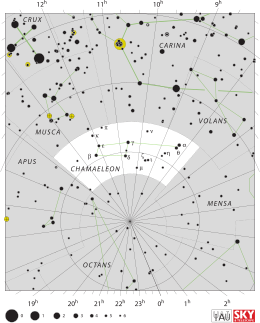Alpha Chamaeleontis
| Observation data Epoch J2000.0 Equinox J2000.0 (ICRS) | |
|---|---|
| Constellation | Chamaeleon |
| Right ascension | 08h 18m 31.55319s[1] |
| Declination | −76° 55′ 10.9964″[1] |
| Apparent magnitude (V) | 4.06[2] |
| Characteristics | |
| Spectral type | F5 V Fe-0.8[3] |
| U−B color index | −0.04[2] |
| B−V color index | +0.40[2] |
| Astrometry | |
| Radial velocity (Rv) | −13.4±0.5[4] km/s |
| Proper motion (μ) | RA: 111.12[1] mas/yr Dec.: 107.49[1] mas/yr |
| Parallax (π) | 51.12 ± 0.12 mas[1] |
| Distance | 63.8 ± 0.1 ly (19.56 ± 0.05 pc) |
| Absolute magnitude (MV) | +2.59[5] |
| Details | |
| Mass | 1.42[6] M☉ |
| Radius | 2.11+0.14 −0.05[7] R☉ |
| Luminosity | 7.542±0.062[7] L☉ |
| Surface gravity (log g) | 4.28±0.14[6] cgs |
| Temperature | 6,580+91 −209[7] K |
| Metallicity [Fe/H] | −0.26[3] dex |
| Rotational velocity (v sin i) | 0[8] km/s |
| Age | 1.8[6] Gyr |
| Other designations | |
| Database references | |
| SIMBAD | data |
Alpha Chamaeleontis, Latinized from α Chamaeleontis, is a solitary[10] star in the southern circumpolar constellation of Chamaeleon. It has an apparent visual magnitude of 4.06[2] and thus is bright enough to be seen with the naked eye. With an annual parallax shift of 51.12 mas,[1] it is located 63.8 light years from the Sun. The star is drifting closer with a radial velocity of −13 km/s,[4] and is predicted to come to within 47 light-years in 666,000 years.[5]
This is an F-type main sequence star with a stellar classification of F5 V Fe−0.8,[3] where the 'Fe−0.8' notation indicates an anomalously low abundance of iron. It has an estimated 1.4 times the mass of the Sun,[6] 2.1 times the Sun's radius,[7] and radiates 7.5 times the solar luminosity from its outer atmosphere at an effective temperature of 6,580 K.[7] The star is around 1.8[6] billion years old with a projected rotational velocity that is too low to be measured.[8] The star has been examined for an infrared excess that would suggest the presence of an orbiting debris disk, but none was found.[11]
References[edit]
- ^ a b c d e f van Leeuwen, F. (2007), "Validation of the new Hipparcos reduction", Astronomy and Astrophysics, 474 (2): 653–664, arXiv:0708.1752, Bibcode:2007A&A...474..653V, doi:10.1051/0004-6361:20078357, S2CID 18759600.
- ^ a b c d Mermilliod, J.-C. (1986), "Compilation of Eggen's UBV data, transformed to UBV (unpublished)", Catalogue of Eggen's UBV Data, SIMBAD, Bibcode:1986EgUBV........0M.
- ^ a b c Gray, R. O.; et al. (2006), "Contributions to the Nearby Stars (NStars) Project: spectroscopy of stars earlier than M0 within 40 pc-The Southern Sample", The Astronomical Journal, 132 (1): 161–70, arXiv:astro-ph/0603770, Bibcode:2006AJ....132..161G, doi:10.1086/504637, S2CID 119476992.
- ^ a b Gontcharov, G. A. (November 2006), "Pulkovo Compilation of Radial Velocities for 35495 Hipparcos stars in a common system", Astronomy Letters, 32 (11): 759–771, arXiv:1606.08053, Bibcode:2006AstL...32..759G, doi:10.1134/S1063773706110065, S2CID 119231169.
- ^ a b Anderson, E.; Francis, Ch. (2012), "XHIP: An extended hipparcos compilation", Astronomy Letters, 38 (5): 331, arXiv:1108.4971, Bibcode:2012AstL...38..331A, doi:10.1134/S1063773712050015, S2CID 119257644.
- ^ a b c d e David, Trevor J.; Hillenbrand, Lynne A. (2015), "The Ages of Early-Type Stars: Strömgren Photometric Methods Calibrated, Validated, Tested, and Applied to Hosts and Prospective Hosts of Directly Imaged Exoplanets", The Astrophysical Journal, 804 (2): 146, arXiv:1501.03154, Bibcode:2015ApJ...804..146D, doi:10.1088/0004-637X/804/2/146, S2CID 33401607.
- ^ a b c d e Brown, A. G. A.; et al. (Gaia collaboration) (August 2018). "Gaia Data Release 2: Summary of the contents and survey properties". Astronomy & Astrophysics. 616. A1. arXiv:1804.09365. Bibcode:2018A&A...616A...1G. doi:10.1051/0004-6361/201833051. Gaia DR2 record for this source at VizieR.
- ^ a b Uesugi, Akira; Fukuda, Ichiro (1970), "Catalogue of rotational velocities of the stars", Contributions from the Institute of Astrophysics and Kwasan Observatory, University of Kyoto, Bibcode:1970crvs.book.....U.
- ^ "alf Cha". SIMBAD. Centre de données astronomiques de Strasbourg. Retrieved 2016-12-10.
{{cite web}}: CS1 maint: postscript (link) - ^ Eggleton, P. P.; Tokovinin, A. A. (September 2008), "A catalogue of multiplicity among bright stellar systems", Monthly Notices of the Royal Astronomical Society, 389 (2): 869–879, arXiv:0806.2878, Bibcode:2008MNRAS.389..869E, doi:10.1111/j.1365-2966.2008.13596.x, S2CID 14878976.
- ^ Gáspár, András; et al. (May 2013), "The Collisional Evolution of Debris Disks", The Astrophysical Journal, 768 (1): 29, arXiv:1211.1415, Bibcode:2013ApJ...768...25G, doi:10.1088/0004-637X/768/1/25, S2CID 119295265, 25.

